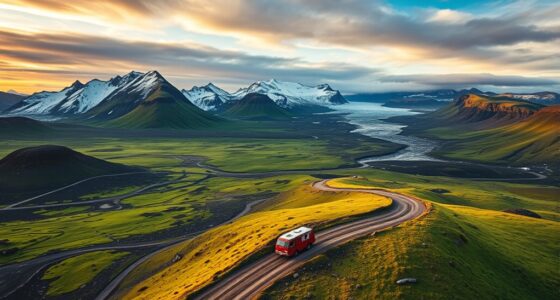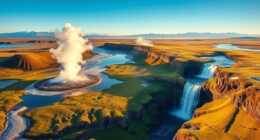Iceland’s history begins with early Norse settlers arriving around 874 AD, forming a unique commonwealth governed by chieftains and assemblies. Over centuries, it experienced periods of internal turmoil, Danish rule, and natural disasters like the 1783 Laki eruption. Today, Iceland maintains a rich cultural heritage with a language rooted in Old Norse, vibrant literature, and traditions. Its modern society values independence, gender equality, and environmental sustainability—explore further to uncover more fascinating details.
Key Takeaways
- Iceland was settled around 874 AD mainly by Norwegians, with early governance through the Alþingi, one of the world’s oldest parliaments.
- The Icelandic Commonwealth operated with regional chieftains and a legal code before Norwegian influence shifted sovereignty in the 13th century.
- Danish rule introduced legal, religious, and cultural changes, including the Protestant Reformation and blending of Norse and Danish heritage.
- Iceland gained full independence in 1944, emphasizing national identity, with a rich literary tradition of sagas, poetry, and folklore.
- Modern Iceland maintains its cultural heritage through language, traditions, and a society focused on environmental sustainability and gender equality.
Early Norse Settlements and Origins
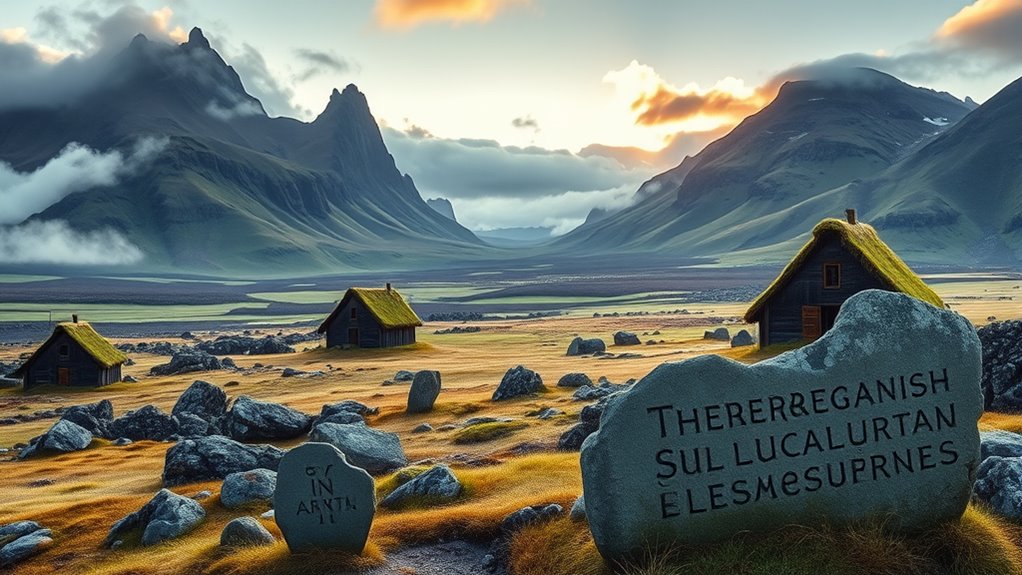
The earliest known settlement in Iceland began around 874 AD when Norse chieftain Ingólfur Arnarson established the first permanent habitation. You’re likely to find that most settlers came from Norway, but Irish and Scottish people, including slaves and mixed-culture Hiberno-Norse, also joined. Settlement spread quickly, with all habitable land claimed within about 60 years. Archaeological evidence suggests some habitation existed as early as 800 AD, predating official records. You might notice that motivations for settling included escaping Norwegian King Harald Fairhair’s rule and overcrowding in Norway’s fjords. This rapid colonization laid the foundation for Iceland’s unique cultural and social development, blending Norse traditions with those of the Irish and Scottish settlers.
Formation of the Icelandic Commonwealth

How did Iceland establish its first form of self-governance? In 930, you set up the Alþingi, one of the world’s earliest parliaments, where chieftains and free men gathered to make laws and settle disputes. Power was shared among regional chieftains called Goðar, rather than centralized in a single ruler. You relied on a legal code called Grágás to guide decisions and maintain order. This system allowed communities to govern themselves while participating in a collective decision-making process. The Alþingi held annual assemblies, where laws were debated and established. This structure created a unique, democratic atmosphere that lasted for over three centuries, shaping Iceland’s identity as a free, self-governing society until political ties with Norway grew stronger in 1262. Additionally, the legal code played a crucial role in formalizing laws and resolving disputes, further strengthening the governance system.
The Age of Sturlungs and Political Turmoil

During the 13th century, Iceland plunged into a period of intense civil conflict known as the Age of Sturlungs, as powerful chieftain families vied for control and influence. You see, these families, led by prominent figures like Snorri Sturluson, fought over land, authority, and political power. The disputes often turned violent, culminating in battles such as the Battle of Örlygsstaðir in 1238, which was the bloodiest of the era. As internal strife worsened, Norwegian interference increased, with many chieftains aligning with the Norwegian king. This chaos weakened Iceland’s independence, eventually leading to the signing of the Old Covenant in 1262–1264. That agreement marked the end of the Icelandic Commonwealth and the beginning of external rule, shifting power away from local chieftains toward foreign authority. Civil conflicts during this period deeply impacted Iceland’s political landscape and sovereignty.
Danish Rule and Cultural Influences

Danish rule profoundly shaped Iceland’s culture, laws, and religious landscape over several centuries. During this period, Danish authorities centralized legal and political control, influencing Icelandic governance. They imposed trade monopolies, which affected local commerce and economic practices. The Protestant Reformation, enforced by Denmark, replaced Catholicism with Lutheranism, transforming religious life across Iceland. Danish officials also introduced new legal codes and administrative structures, which integrated Iceland into a broader Scandinavian framework. You can see Danish influence in Icelandic art, architecture, and education, which adopted many Scandinavian styles and ideas. Despite these changes, Icelanders maintained their language and cultural identity, blending Danish elements with their Norse heritage. This period left a lasting mark, shaping modern Iceland’s societal and cultural foundations.
Natural Disasters and Their Consequences

You can’t overlook the Laki eruption of 1783, which released toxic gases and caused widespread famine in Iceland. This disaster led to a dramatic population decline and disrupted the country’s economy for decades. Its effects also spread beyond Iceland, impacting global weather patterns and agriculture worldwide. Additionally, the eruption underscored the importance of understanding volcanic hazards and their far-reaching consequences.
Laki Eruption Devastation
The Laki eruption of 1783 stands out as one of Iceland’s most catastrophic natural disasters, releasing a torrent of volcanic ash, toxic gases, and lava that blanketed the landscape. Over eight months, the eruption released vast quantities of sulfur dioxide and other gases, causing widespread poisoning of livestock and humans. Nearly a quarter of Iceland’s population perished from famine and disease, and the economy suffered a severe blow. The eruption’s climatic effects were felt globally, cooling temperatures and triggering harsh winters across Europe, India, and North America. The ash darkened skies and contaminated water sources, disrupting daily life for years. The devastation marked a turning point, illustrating the profound power of natural forces to reshape Iceland’s society, environment, and history for generations. Notably, the eruption’s volcanic hazards demonstrated the importance of understanding and monitoring natural disasters to mitigate future risks.
Famine and Population Decline
The Laki eruption in 1783 had devastating effects that extended well beyond the volcanic landscape, directly triggering widespread famine and population decline. You experience how toxic gases killed livestock and ruined crops, leading to a sharp drop in food supplies. As a result, about a quarter of Iceland’s population perished, and many others emigrated. The disaster’s impact wasn’t limited locally but affected global climate patterns, causing colder weather and failed harvests across Europe and beyond. Additionally, the event significantly influenced climate change and environmental conditions, demonstrating how natural disasters can have far-reaching effects on societal stability.
Global Climatic Effects
Natural disasters in Iceland have had far-reaching effects on the global climate, especially during major eruptions like the Laki event of 1783. When Laki erupted, it released vast amounts of sulfur dioxide and ash into the atmosphere, leading to a global cooling effect. Temperatures dropped across Europe, causing failed harvests and widespread famine. The ash cloud also disrupted weather patterns, resulting in heavy rains and crop failures in North America and India. These climatic disturbances persisted for years, impacting agriculture, economy, and health worldwide. Iceland’s volcanic activity demonstrates how natural events in this small island can influence broader environmental systems. Understanding these effects highlights the interconnectedness of Earth’s climate and the importance of monitoring volcanic activity for global stability. Promoting awareness of volcanic hazards and their potential climate impacts is crucial for global resilience.
Path to Independence and Sovereignty
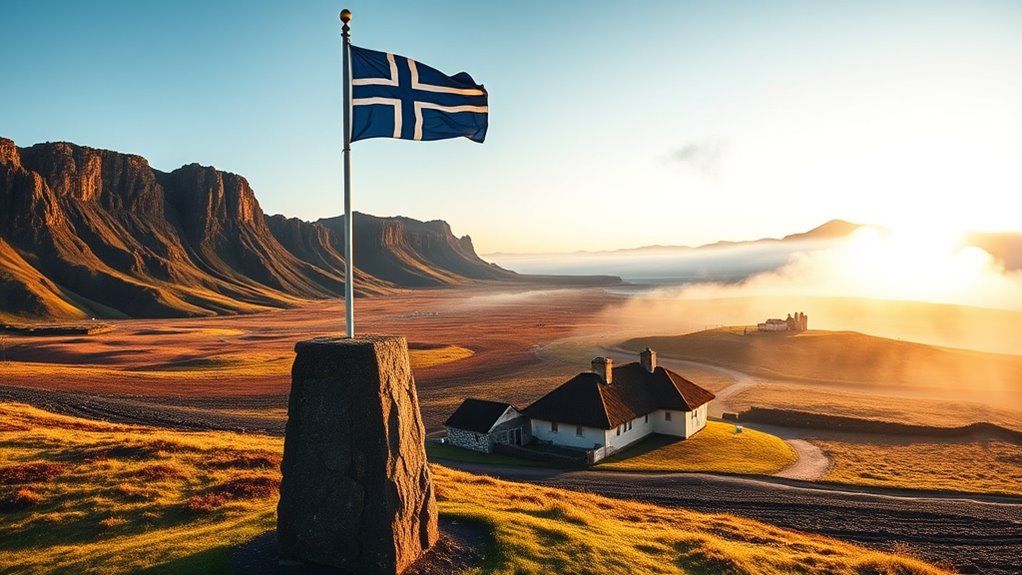
You see how Iceland’s journey toward independence involved gaining greater autonomy from Denmark through constitutional changes and agreements like the 1918 Act of Union. World War II played a vital role by bringing foreign forces to Iceland’s shores, which accelerated discussions about full sovereignty. Ultimately, you witness how Iceland declared itself a republic in 1944, ending Danish ties and establishing its own independent government.
Danish Union and Autonomy
Following centuries of Danish rule, Iceland began to seek greater autonomy in the late 19th and early 20th centuries as national identity and political consciousness grew. You can see this shift in key developments:
- In 1874, Denmark granted Iceland a constitution, allowing limited self-governance and marking the start of increased autonomy.
- The 1918 Danish–Icelandic Act of Union recognized Iceland as a sovereign state in personal union with Denmark, giving it control over most internal affairs while sharing monarchic ties.
- During this period, Iceland developed its own symbols, such as a flag, and began asserting its national identity, setting the stage for full independence.
- The process of gradual political autonomy laid the foundation for Iceland’s full independence, which was achieved in 1944.
These steps reflected Iceland’s desire for self-rule, gradually reducing Danish control and nurturing its national sovereignty.
World War II Impact
Did World War II considerably accelerate Iceland’s journey toward full independence? Absolutely. When Allied forces occupied Iceland in 1940 to secure North Atlantic routes, the country’s strategic importance grew. You experienced increased political pressure to take control of your own affairs. The occupation demonstrated your capacity for self-governance and strengthened your push for independence. On June 17, 1944, you declared yourself a republic, ending Danish ties. This pivotal moment was also influenced by the geopolitical significance of Iceland during the war, which underscored its vital role in international security.
Icelandic Independence Achieved
The momentum toward full independence gained significant strength during World War II, when the Allied occupation underscored Iceland’s strategic importance and demonstrated its capacity for self-governance. You can see this shift in how Iceland took control of its future. Key milestones include:
- The 1918 Act of Union, which recognized Iceland as a sovereign state in personal union with Denmark, with its own symbols.
- The 1944 declaration of full republic status on June 17, ending Danish ties and establishing complete independence.
- The post-war period, where Iceland expanded its sovereignty, built a democratic government, and joined international organizations like the UN.
- The growth of investment platforms and the increasing popularity of democratized financial tools also reflected Iceland’s broader trend towards independence and self-reliance on the global stage.
These steps marked Iceland’s journey from Danish rule to a fully independent republic, shaping its identity today.
Icelandic Heritage: Language, Literature, and Traditions

Icelandic heritage is deeply rooted in a rich language, vibrant literature, and enduring traditions that reflect the island’s Norse origins. The Icelandic language, derived from Old Norse, remains remarkably preserved, keeping ancient words and grammar alive. Literature thrives through sagas, poetic Eddas, and modern works that celebrate history and storytelling. Traditional customs, like the New Year’s fireworks and community gatherings, connect you to Iceland’s Viking past. Here’s a look at key aspects:
| Aspect | Significance |
|---|---|
| Language | Preserves Old Norse roots, fostering cultural identity |
| Literature | Saga storytelling, poetry, and modern Icelandic novels |
| Traditions | Festivals, folklore, and communal celebrations |
| Folklore | Elves, trolls, and spirits embedded in daily life |
| Craftsmanship | Wool, woodwork, and Viking-inspired artistry |
Modern Iceland: Society, Governance, and National Identity
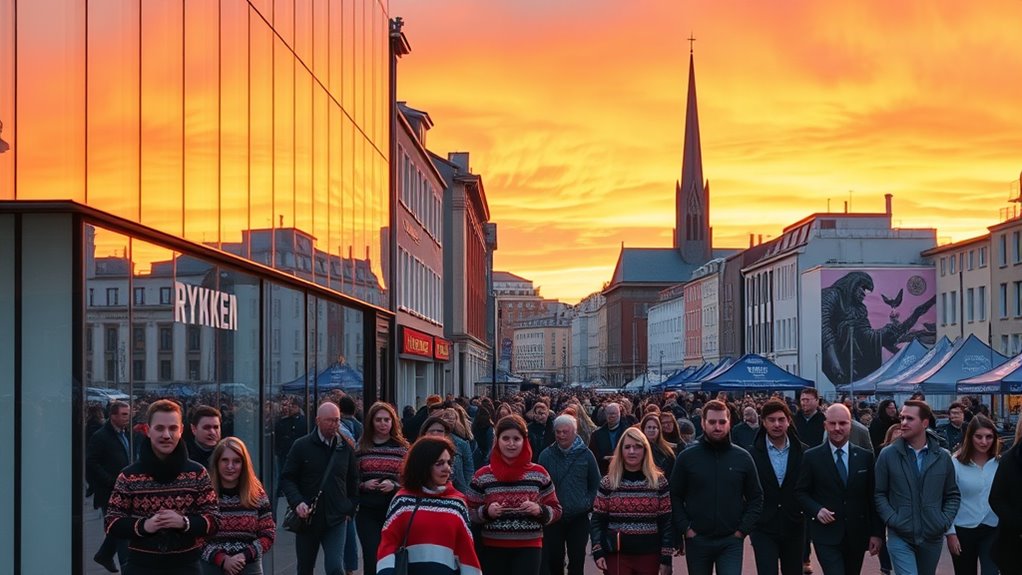
Modern Iceland has transformed into a vibrant, democratic society that values equality, environmental sustainability, and cultural heritage. You’ll find a nation that emphasizes social welfare, gender equality, and renewable energy. Here are three key aspects of modern Iceland:
- Governance: Iceland operates as a parliamentary republic, with a president and a prime minister leading a transparent government. The Alþingi remains a symbol of its democratic roots.
- Society: Equality is central, with women holding significant political and economic roles. Community involvement and social cohesion drive the nation’s progress.
- Identity: Icelanders take pride in their cultural heritage, blending ancient traditions with modern values. Environmental consciousness shapes policies, especially in renewable energy and conservation efforts. Additionally, the country’s remote work culture has grown, contributing to flexible lifestyles and increased global engagement.
Frequently Asked Questions
How Did Norse Settlers Influence Modern Icelandic Culture?
You can see Norse settlers’ influence in modern Icelandic culture through language, customs, and legal traditions. The Icelandic language remains very close to Old Norse, preserving ancient words and grammar. You also embrace a strong storytelling tradition, especially sagas, that highlight Norse values and history. Additionally, Iceland’s governance and legal principles were shaped by Norse assemblies like the Alþingi, which still inspire democratic practices today.
What Role Did Iceland Play During World War II?
During World War II, you’ll find Iceland playing the role of the strategic pawn, not the king. You’re caught between the British and Americans, who occupy your land to prevent Nazi advances, turning your island into a crucial military hub. While you quietly endure, this occupation accelerates your push toward full independence, transforming your neutral, Viking-inspired society into a modern nation with a taste for sovereignty.
How Has Iceland Preserved Its Viking Heritage Today?
You can see Iceland preserves its Viking heritage through its language, which still reflects Old Norse roots, and its traditional sagas that recount Viking legends. You might visit museums showcasing Viking artifacts or participate in reenactments of Viking rituals. Many Icelanders wear Viking-inspired clothing, and festivals celebrate their Norse ancestors. Even in modern culture, Icelandic law, folklore, and place names echo their Viking origins, keeping their heritage alive today.
What Are Unique Icelandic Traditions Still Practiced Now?
You’ll find Iceland’s traditions alive like the flickering flame of a Viking torch. Celebrating the Alþingi with lively gatherings, you witness storytelling and debates echoing ancient governance. You might indulge in hearty Þorramatur, traditional winter fare, or chase the Northern Lights, a celestial dance rooted in old beliefs. Folk music, sagas, and the art of storytelling still weave the fabric of Icelandic culture, connecting you to the island’s storied past in every moment.
How Does Iceland’s Legal System Compare to Other Countries?
You’ll find Iceland’s legal system unique because it’s based on a centuries-old tradition rooted in the Alþingi, one of the world’s oldest parliaments. Unlike many countries, Iceland still uses a blend of customary law, written statutes, and a strong emphasis on community consensus. The system promotes transparency and citizen participation, making it more accessible and democratic compared to more centralized or bureaucratic legal frameworks found elsewhere.
Conclusion
As you explore Iceland’s rich history and vibrant culture, remember that understanding the past shapes the future. From Norse roots to modern independence, each chapter teaches resilience and unity. Embrace the idea that “what’s past is prologue,” for Iceland’s stories remind you that overcoming challenges paves the way for new beginnings and enduring identity. Your journey through Iceland’s history offers insights that inspire strength and hope for tomorrow.




